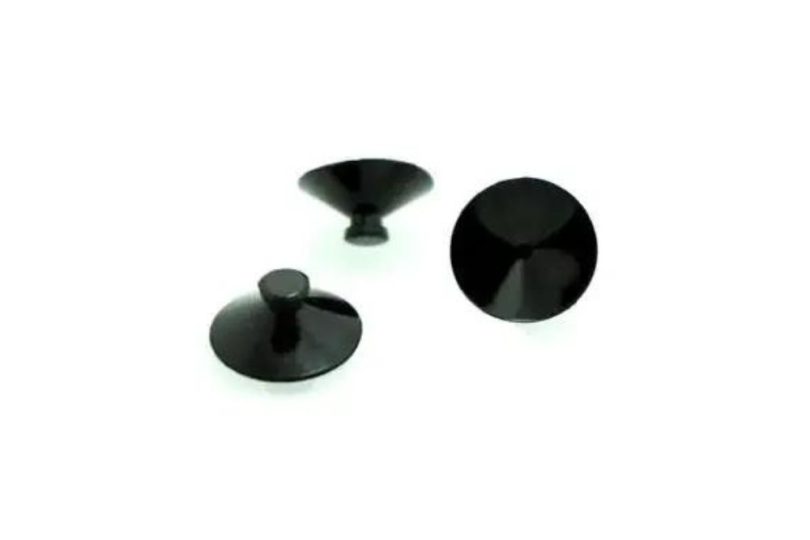Table of Contents
If you are an aquarium enthusiast, you probably know the struggle of keeping those pesky suction cups attached to the tank glass. There’s nothing more frustrating than coming back to find your decorations or equipment floating around because the suction cups didn’t hold up as expected.
But fear not! In this article, we’ll explore some essential tips and tricks on how to keep aquarium suction cups firmly attached to the tank glass. Say goodbye to floating decorations and equipment mishaps!
Understanding Aquarium Suction Cups
Before we dive into the ways of keeping suction cups in place, let’s understand how they work. Aquarium suction cups utilize the principle of negative pressure or vacuum to stay attached to the glass surface.
When you press the cup against the glass and remove the air from inside the cup, a vacuum is created, holding the suction cup firmly in place.
However, several factors can lead to the suction cups losing their grip over time. One common reason is the accumulation of debris or algae on the glass surface, which prevents a tight seal.
Additionally, the quality and material of the suction cups can also play a significant role in their performance. Now that we know the basics let’s move on to the main topic—how to ensure your suction cups stay put!
Selecting the Right Suction Cup for Your Tank
When it comes to keeping your aquarium suction cups secure, choosing the right type of suction cup is crucial. Here are some factors to consider:
Material Considerations
The material of the suction cup can greatly impact its longevity and performance. Opt for high-quality suction cups made from durable materials like silicone or rubber.
These materials are less prone to wear and tear and provide a better grip on the glass surface. Avoid cheap plastic suction cups, as they tend to become brittle and lose their suction power quickly.
Size and Shape Factors
The size and shape of the suction cup also matter. Larger suction cups generally have a stronger hold as they create more surface area for the vacuum seal.
However, make sure the size of the suction cup aligns with the weight of the object it needs to hold. For heavier decorations or equipment, use larger suction cups for added security.
Moreover, consider the shape of the suction cup. Flat-surfaced suction cups tend to adhere better to the glass than curved ones. If you have a choice, go for flat suction cups to ensure a stronger and longer-lasting hold.
Now that we’ve covered the fundamentals of selecting the right suction cups, let’s move on to some practical tips to keep them firmly attached to the tank glass.
Proper Installation of Suction Cups
The first step to ensuring your suction cups stay firmly attached to the tank glass is their proper installation. Here’s a step-by-step guide to help you get it right:
- Clean the Glass Surface: Before attaching any suction cups, it’s crucial to clean the glass surface where they will be placed. Use an aquarium-safe glass cleaner or a mixture of white vinegar and water to remove any dirt, algae, or residue. This will create a clean and smooth surface for the suction cups to adhere to.
- Moisten the Suction Cup: To enhance the suction cup’s grip, moisten the inner surface with a small amount of water. This helps to create a stronger seal when pressed against the glass.
- Press Firmly on the Glass: Position the suction cup at the desired location on the tank glass. Apply steady and firm pressure, pressing the suction cup against the glass. Make sure there are no air bubbles trapped between the suction cup and the glass, as this can cause it to lose grip over time.
- Attach the Equipment: Once the suction cups are securely in place, you can attach your aquarium equipment to them. Ensure that the equipment is properly positioned and supported by the suction cups to prevent any accidental falls.
- Periodic Check-ups: As a precaution, it’s a good idea to check the suction cups and the attached equipment regularly. Over time, suction cups may lose their grip due to factors like algae growth or changes in water chemistry. By performing periodic check-ups, you can catch any issues early and reposition the suction cups if needed.
Remember, if you ever need to reposition a suction cup, it’s best to remove it completely, clean both the glass and the suction cup, and then reinstall it using the steps mentioned above.
Cleaning the Tank Glass
Maintaining a clean tank glass not only keeps your aquarium looking pristine but also plays a significant role in helping suction cups adhere more effectively. Here are some tips for cleaning the tank glass:
- Regular Cleaning Routine: Incorporate tank glass cleaning into your regular aquarium maintenance routine. Depending on your tank’s size and stocking level, clean the glass at least once a week or as needed.
- Use Aquarium-Safe Algae Scrubber or Razor Blade: To remove stubborn algae or mineral deposits, consider using an aquarium-safe algae scrubber or a razor blade specifically designed for aquarium use. These tools can help you scrape off tough buildup without causing any damage to the glass.
- Avoid Harsh Chemicals: While it may be tempting to use household glass cleaners, avoid doing so, as they often contain chemicals that can be harmful to your aquatic life. Stick to aquarium-safe glass cleaners or use the vinegar-water mixture mentioned earlier.
- Clean Both Sides: Don’t forget to clean the outside of the tank glass too, as algae and grime can accumulate on the external surface as well. A clean exterior not only looks better but also allows you to view your fish and plants more clearly.
- Check Water Parameters: Sometimes, excessive algae growth can be an indication of an imbalance in water parameters. Test the water regularly and address any issues to prevent recurring algae problems.
Placement Strategy
Strategically placing your aquarium equipment and considering the layout can contribute to better suction cup adhesion. Here are some placement tips to keep in mind:
- Avoid Directly Above Substrates: When positioning suction cups, avoid placing them directly above substrates like gravel or sand. These substrates might not provide enough support, leading to the suction cups losing grip over time. Instead, attach the equipment slightly away from the substrate.
- Distribute Weight Evenly: If you have multiple pieces of equipment to attach, try to distribute their weight evenly along the tank glass. This ensures that no single suction cup is bearing excessive weight, reducing the risk of detachment.
- Consider Water Flow: Take into account the water flow in your aquarium when placing equipment. Suction cups holding equipment that produces strong water currents should be attached firmly to prevent them from shifting or falling.
- Keep Away from Aggressive Fish: If you have aggressive fish species in your tank, they might sometimes nip at or disturb the equipment attached to the glass. In such cases, position the equipment in areas of the tank that are less accessible to these fish.
- Organize Cords and Hoses: Messy cords and hoses can inadvertently dislodge suction cups. Neatly organize and secure cords and hoses to prevent them from getting tangled with the equipment or the suction cups.
By considering the placement strategy, you can ensure that your suction cups have the best chance of staying securely attached to the tank glass, providing a stable and functional setup for your aquarium equipment.
Applying Pressure
One of the critical factors in maintaining the adhesion of suction cups is applying the right amount of pressure during installation. Here are some essential tips for applying pressure effectively:
- Even and Firm Pressure: When pressing the suction cup against the glass, apply even and firm pressure. Avoid using excessive force, as it can damage the suction cup or the glass, and don’t be too gentle, as it may not create a strong seal.
- Thumb Technique: To apply pressure evenly, use your thumb in the center of the suction cup’s surface while supporting the backside of the suction cup with your fingers. This technique helps you control the pressure distribution more effectively.
- Hold for a Few Seconds: After attaching the suction cup to the glass, hold it in place for a few seconds to allow the suction cup to conform to the glass surface and create a secure seal.
- Avoid Disturbing the Seal: Once the suction cup is in place, avoid disturbing the seal unnecessarily. Frequent removal and reinstallation can wear down the suction cup’s grip and reduce its effectiveness over time.
- Monitor the Equipment Weight: If you’re attaching heavier equipment, be especially cautious about the pressure applied during installation. Consider having an extra pair of hands to help you ensure a secure attachment
Maintaining Suction Cup Adherence
Regular Inspection
Regular inspection of your aquarium suction cups is essential for ensuring they remain in perfect working condition.
Over time, dust, algae, and other debris can accumulate on the suction cups’ surfaces, preventing them from sticking effectively. To maintain strong adherence, make it a habit to inspect the suction cups at least once a week.
Use a soft brush or cloth to gently clean the suction cups and the tank glass where they will be attached. Avoid using harsh chemicals or abrasive materials, as they could damage the suction cup’s surface or the glass. A mixture of warm water and mild dish soap should be sufficient for most cleaning needs.
Replacing Worn Out Suction Cups
Suction cups are not invincible and can wear out over time, especially in aquarium environments where they are exposed to water and constant pressure.
If you notice any signs of wear, such as cracks, tears, or loss of flexibility, it’s time to replace the suction cups.
Before buying replacement suction cups, ensure they are the appropriate size and type for your specific aquarium setup.
Consider investing in high-quality suction cups that are specifically designed for aquarium use, as they tend to be more durable and reliable.
Common Problems and Solutions
Suction Cup Won’t Stick
Have you ever experienced the frustration of trying to attach a suction cup to the aquarium glass, only to have it refuse to stick?
This issue commonly occurs due to air or debris trapped between the suction cup and the glass surface. To resolve this problem, follow these steps:
- Clean the Suction Cup and Glass: Thoroughly clean both the suction cup and the glass surface with warm water and a gentle soap. Make sure there are no residues or particles that could hinder the suction.
- Wet the Suction Cup: Before attempting to attach the suction cup, wet it with some aquarium water. Wetting the suction cup helps eliminate air pockets and creates a better seal.
- Press Firmly and Remove Air: Press the suction cup firmly against the glass and, using your fingers, try to remove any remaining air trapped between the suction cup and the glass. Press down and smooth out the cup’s edges to maximize contact.
- Wait for Adhesion: After applying the suction cup, give it a few moments to adhere properly. Avoid disturbing it during this time to allow the seal to form securely.
- Check for Leaks: Observe the suction cup to ensure there are no air leaks. If you notice any bubbles forming between the cup and the glass, repeat the steps above.
Suction Cup Keeps Falling
If you find that your suction cups keep falling off the glass, it can be immensely frustrating. This problem can occur due to various factors, but don’t worry; there are several solutions you can try:
- Check the Suction Cup Size: Ensure that the suction cups you’re using are the right size and appropriate for the weight of the decorations or equipment you’re trying to attach. If the cups are too small or weak for the task, they will likely fail to hold.
- Evaluate the Glass Surface: The texture and cleanliness of the glass surface can significantly affect suction cup adherence. If the glass has scratches, rough patches, or mineral deposits, it may hinder the suction cup’s ability to stick. Consider cleaning or smoothing the glass if needed.
- Improve Water Quality: Poor water quality can lead to algae growth on the glass, making it difficult for suction cups to stay in place. Regularly monitor and maintain the water quality in your aquarium to prevent excessive algae buildup.
- Use Multiple Suction Cups: Distribute the weight of heavy decorations or equipment by using multiple suction cups. This can provide better stability and reduce the risk of individual suction cups failing.
- Try Suction Cup Clips or Holders: In some cases, using additional tools like suction cup clips or holders can enhance the stability of decorations or equipment. These accessories can help secure the items in place, even if one suction cup fails.
Conclusion
Keeping aquarium suction cups attached to the tank glass is a manageable task with the right approach. By selecting the right suction cups, properly cleaning the glass surface, moistening the suction cups, applying pressure while attaching, choosing suitable locations, and performing regular maintenance, you can enjoy a well-decorated and efficiently equipped aquarium without the hassle of constantly reattaching the suction cups.
to use additional support like suction cup clips or holders when needed and avoid overloading the suction cups with heavy objects.
With these tips, you’ll have a stable and beautiful aquarium that brings you joy for years to come. Happy fishkeeping!







